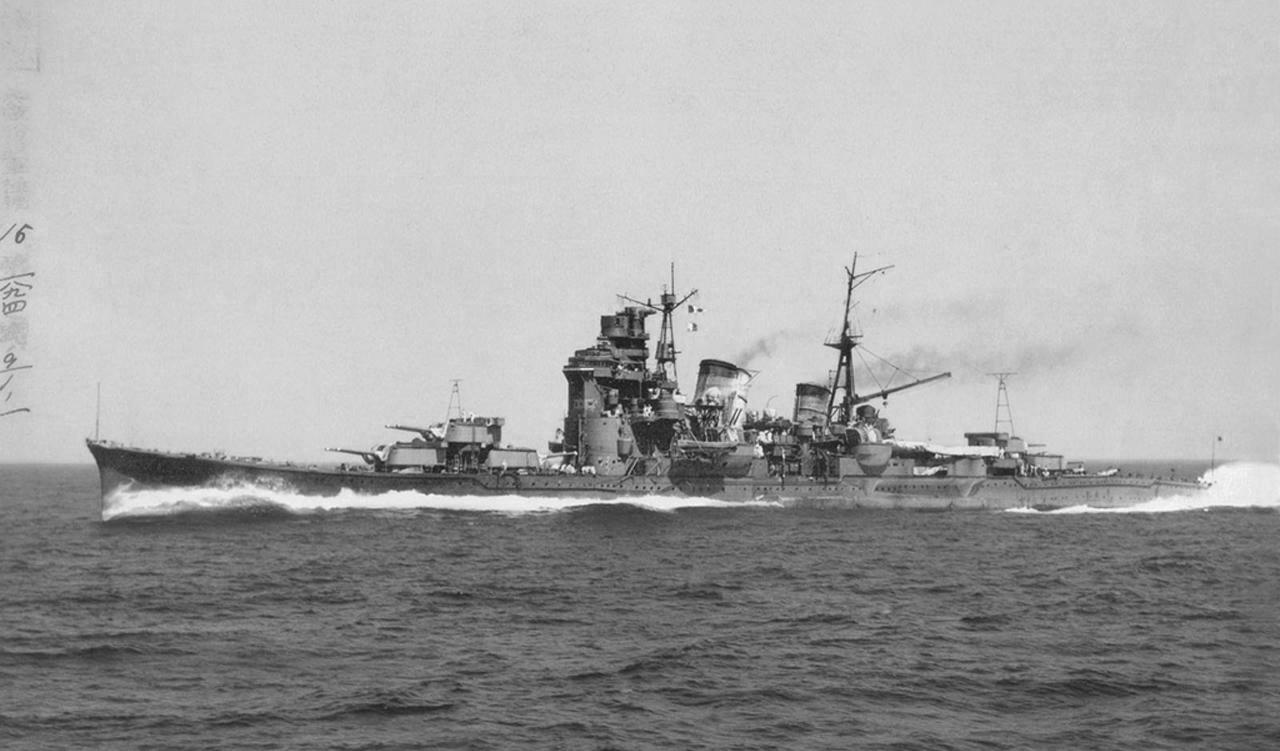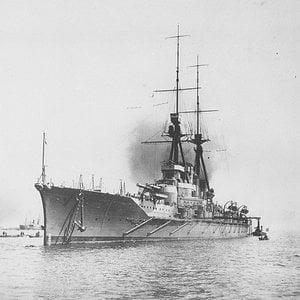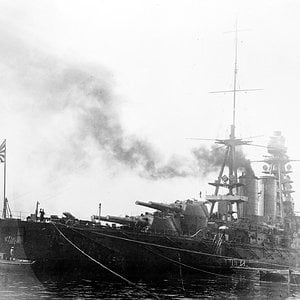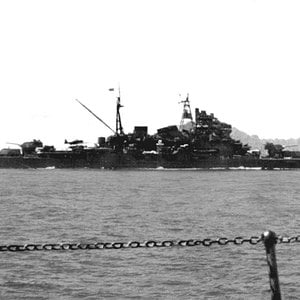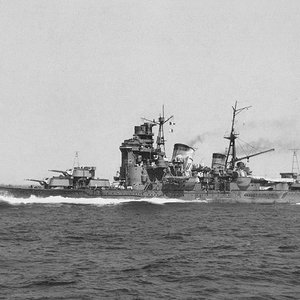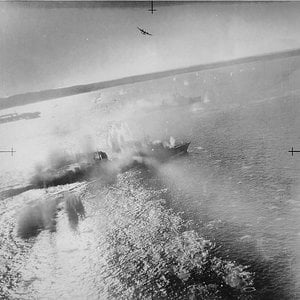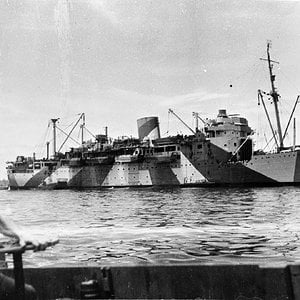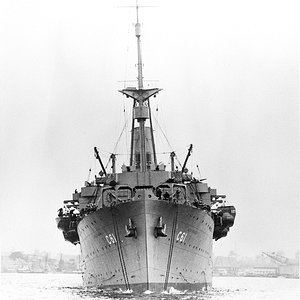Navigation
Install the app
How to install the app on iOS
Follow along with the video below to see how to install our site as a web app on your home screen.
Note: This feature may not be available in some browsers.
More options
You are using an out of date browser. It may not display this or other websites correctly.
You should upgrade or use an alternative browser.
You should upgrade or use an alternative browser.
IjNS Myoko 31st March 1941
Myoko was the name-ship of the four-member Myōkō class of heavy cruisers of the Imperial Japanese Navy — the other ships of the class being the Nachi, Ashigara, and Haguro.
The ships of this class displaced 13,300 tons, were 204 metres long, and were capable of 36 knots (67 km/h). They carried two floatplanes and their main armament was ten 8-inch (203 mm) guns, the heaviest armament of any heavy cruiser in the world at the time.
Myoko was laid down at the Yokosuka Naval Arsenal on 25 October 1924, launched and named on 16 April 1927, and was commissioned into the Imperial Japanese Navy on 31 July 1929. She was named after Mount Myōkō in Niigata Prefecture
During the Second Sino-Japanese War the Myōkō participated in the Amoy Operation from 10–12 May 1938. Also the heavy cruisers Myōkō, Nagara and Nachi participated in the Hainan Island Operation in February 1939 under Vice Admiral Nobutake Kondō. Myōkō was the flagship of the admiral.
The heavy cruisers Myōkō and Nachi formed Cruiser Division Five (CruDiv 5), commanded by Rear Adm. Takeo Takagi, part of the Cover Force for "Operation M" — the invasion of the southern Philippine Islands. The flagship of the Cover Force was the light aircraft carrier Ryujo, carrying the flag of Vice Adm. Ibō Takahashi. Completing the Cover Force roster were the light cruiser Jintsu and eight destroyers. This force gave cover for the landings at Davao and Legaspi in December 1941.
In a reorganization in late December, CruDiv5 became part of the Attack Force under the Rear Adm. Raizō Tanaka. This included the aircraft carriers Ryujo and Chitose, the cruisers Nagara and Naka, five destroyers and seven troop transports.
On 4 January 1942 the Myōkō and the other vessels of the Attack Force were attacked by American B-17 Flying Fortress bombers. The Myōkō was hit by one 227 kg (500 lb) bomb. The damage was superficial, but she was drydocked at Sasebo for repairs.
In the Battle of the Java Sea on 1 March 1942 the Myōkō participated in the destruction of the last remaining Allied fleet units in the East Indies. At 11:50, the Myōkō, Ashigara and two destroyers opened fire on the damaged British heavy cruiser Exeter and her escort of two destroyers. The 8-inch guns of the Myōkō helped to cripple the destroyer HMS Encounter which had to be scuttled.
Later in March, the Myōkō received a refit at Sasebo. In April, she participated in the unsuccessful pursuit of the Doolittle raid task force.
In May, Myōkō was part of the escort for the Tulagi invasion force in the Battle of the Coral Sea, under the command of Rear Adm. Chūichi Hara. This force consisted of the aircraft carriers Shōkaku and Zuikaku, the heavy cruisers Myōkō and Haguro, and five destroyers. The Shōkaku was damaged by American aircraft and the Zuikaku lost most of her aircraft in the Battle of the Coral Sea, so the flotilla was forced to withdraw without invading Port Moresby.
In June, CruDiv 5 was part of Vice Adm. Nobutake Kondō's Support Force in the Battle of Midway. The force consisted of the battleships Kongo and Hiei, the heavy cruisers Myōkō, Haguro, Atago and Chokai, the light cruiser Yura, the light aircraft carrier Zuiho and seven destroyers. The Support Force did not engage the enemy in this battle.
At the end of June, CruDiv 5 supported the reinforcement convoy bound for the freshly captured islands of Attu and Kiska in the Aleutian Islands. The entire task force consisted of the aircraft carrier Zuikaku, the light aircraft carriers Zuiho, Junyo and Ryujo, the heavy cruisers Maya, Takao, Myōkō, Haguro and Nachi, the light cruisers Abukuma, Kiso and Tama, and 15 destroyers.
In June 1944, CruDiv 5 participated in the Battle of the Philippine Sea. The Japanese fleet sailed from its anchorage at Tawi Tawi in response to the American invasion of the Marianas Islands. The Japanese high command was aware that American heavy bombers, based in the Marianas, could eventually reach Japanese factories and shipyards in the Home Islands. This battle was later called the "Great Marianas Turkey Shoot" by American sailors, because over 300 Japanese carrier aircraft were shot down in a single day on 19 June.
After participating in the Battle of Leyte Gulf, on her way to Cam Ranh Bay, the Myōkō was hit by one torpedo from a spread of six, fired by USS Bergall at 17:35 on 13 December 1944. She was towed by destroyer Ushio (which assisted in damaging Bergall, which survived and returned to Fremantle) and several other ships to Singapore Harbor for repairs, but there were insufficient materials in Singapore to complete the repairs to both Myōkō and Takao, which was also in harbor for repairs.
In February 1945, the harbor commander reported that the Myōkō was irreparable at Singapore without more materials, and impossible to tow to Japan. He recommended that Myōkō be kept in Singapore as a floating AA battery. This suggestion was approved and, although both Myōkō and Takao were targeted by British midget submarine attacks on 26 July, Myōkō survived the war. Myōkō formally surrendered to British units on 21 September, and was subsequently towed to the Strait of Malacca and scuttled off at WikiMiniAtlas
3°5′N 100°40′E / 3.083°N 100.667°E / 3.083; 100.667Coordinates: 3°5′N 100°40′E / 3.083°N 100.667°E / 3.083; 100.667 Port Swettenham, Malaya (near present day Port Klang, Malaysia) near submarines I-501 and I-502
Myoko was the name-ship of the four-member Myōkō class of heavy cruisers of the Imperial Japanese Navy — the other ships of the class being the Nachi, Ashigara, and Haguro.
The ships of this class displaced 13,300 tons, were 204 metres long, and were capable of 36 knots (67 km/h). They carried two floatplanes and their main armament was ten 8-inch (203 mm) guns, the heaviest armament of any heavy cruiser in the world at the time.
Myoko was laid down at the Yokosuka Naval Arsenal on 25 October 1924, launched and named on 16 April 1927, and was commissioned into the Imperial Japanese Navy on 31 July 1929. She was named after Mount Myōkō in Niigata Prefecture
During the Second Sino-Japanese War the Myōkō participated in the Amoy Operation from 10–12 May 1938. Also the heavy cruisers Myōkō, Nagara and Nachi participated in the Hainan Island Operation in February 1939 under Vice Admiral Nobutake Kondō. Myōkō was the flagship of the admiral.
The heavy cruisers Myōkō and Nachi formed Cruiser Division Five (CruDiv 5), commanded by Rear Adm. Takeo Takagi, part of the Cover Force for "Operation M" — the invasion of the southern Philippine Islands. The flagship of the Cover Force was the light aircraft carrier Ryujo, carrying the flag of Vice Adm. Ibō Takahashi. Completing the Cover Force roster were the light cruiser Jintsu and eight destroyers. This force gave cover for the landings at Davao and Legaspi in December 1941.
In a reorganization in late December, CruDiv5 became part of the Attack Force under the Rear Adm. Raizō Tanaka. This included the aircraft carriers Ryujo and Chitose, the cruisers Nagara and Naka, five destroyers and seven troop transports.
On 4 January 1942 the Myōkō and the other vessels of the Attack Force were attacked by American B-17 Flying Fortress bombers. The Myōkō was hit by one 227 kg (500 lb) bomb. The damage was superficial, but she was drydocked at Sasebo for repairs.
In the Battle of the Java Sea on 1 March 1942 the Myōkō participated in the destruction of the last remaining Allied fleet units in the East Indies. At 11:50, the Myōkō, Ashigara and two destroyers opened fire on the damaged British heavy cruiser Exeter and her escort of two destroyers. The 8-inch guns of the Myōkō helped to cripple the destroyer HMS Encounter which had to be scuttled.
Later in March, the Myōkō received a refit at Sasebo. In April, she participated in the unsuccessful pursuit of the Doolittle raid task force.
In May, Myōkō was part of the escort for the Tulagi invasion force in the Battle of the Coral Sea, under the command of Rear Adm. Chūichi Hara. This force consisted of the aircraft carriers Shōkaku and Zuikaku, the heavy cruisers Myōkō and Haguro, and five destroyers. The Shōkaku was damaged by American aircraft and the Zuikaku lost most of her aircraft in the Battle of the Coral Sea, so the flotilla was forced to withdraw without invading Port Moresby.
In June, CruDiv 5 was part of Vice Adm. Nobutake Kondō's Support Force in the Battle of Midway. The force consisted of the battleships Kongo and Hiei, the heavy cruisers Myōkō, Haguro, Atago and Chokai, the light cruiser Yura, the light aircraft carrier Zuiho and seven destroyers. The Support Force did not engage the enemy in this battle.
At the end of June, CruDiv 5 supported the reinforcement convoy bound for the freshly captured islands of Attu and Kiska in the Aleutian Islands. The entire task force consisted of the aircraft carrier Zuikaku, the light aircraft carriers Zuiho, Junyo and Ryujo, the heavy cruisers Maya, Takao, Myōkō, Haguro and Nachi, the light cruisers Abukuma, Kiso and Tama, and 15 destroyers.
In June 1944, CruDiv 5 participated in the Battle of the Philippine Sea. The Japanese fleet sailed from its anchorage at Tawi Tawi in response to the American invasion of the Marianas Islands. The Japanese high command was aware that American heavy bombers, based in the Marianas, could eventually reach Japanese factories and shipyards in the Home Islands. This battle was later called the "Great Marianas Turkey Shoot" by American sailors, because over 300 Japanese carrier aircraft were shot down in a single day on 19 June.
After participating in the Battle of Leyte Gulf, on her way to Cam Ranh Bay, the Myōkō was hit by one torpedo from a spread of six, fired by USS Bergall at 17:35 on 13 December 1944. She was towed by destroyer Ushio (which assisted in damaging Bergall, which survived and returned to Fremantle) and several other ships to Singapore Harbor for repairs, but there were insufficient materials in Singapore to complete the repairs to both Myōkō and Takao, which was also in harbor for repairs.
In February 1945, the harbor commander reported that the Myōkō was irreparable at Singapore without more materials, and impossible to tow to Japan. He recommended that Myōkō be kept in Singapore as a floating AA battery. This suggestion was approved and, although both Myōkō and Takao were targeted by British midget submarine attacks on 26 July, Myōkō survived the war. Myōkō formally surrendered to British units on 21 September, and was subsequently towed to the Strait of Malacca and scuttled off at WikiMiniAtlas
3°5′N 100°40′E / 3.083°N 100.667°E / 3.083; 100.667Coordinates: 3°5′N 100°40′E / 3.083°N 100.667°E / 3.083; 100.667 Port Swettenham, Malaya (near present day Port Klang, Malaysia) near submarines I-501 and I-502

